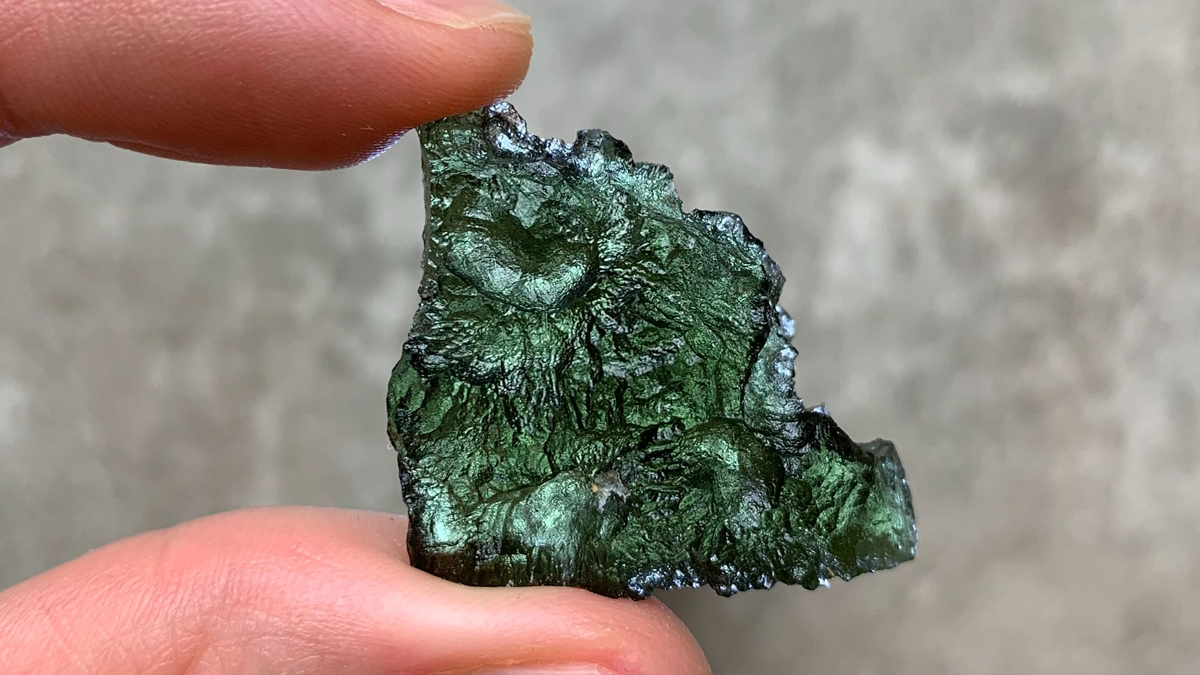
Moldavite is a forest green stone that was formed by a meteoric impact. This rock has unique characteristics and is one of the most beautiful and powerful gemstones. Unfortunately, since the demand for moldavite grew exponentially, many sellers have replicated the stone with counterfeit pieces in an attempt to make a profit and trick the unsuspecting buyers. So, it’s important to learn the specifics of the stone’s appearance and texture to ensure that you are getting a genuine, true moldavite stone and not a knock-off. Here’s how you can tell if your moldavite is real.
Color and Texture
Real Moldavite is an olive-green color; you’ll find that all stones often range from a light to deep green color with some brown streaks in them. Bear in mind that some stone colors can appear black in certain lighting. However, each stone has various hues, so some will have a pale or translucent complexion. Although stones can obtain both a matte or glossy appearance if they are too polished and varnished with a shiny finish, thereby producing glass-type transparency counterfeit stones. In other words, any stone that appears glass-like or transparent is most definitely fake.
The texture of a stone may vary as some are sculpted and some are smoothed out and some have a combination of both textures. A stone’s surroundings can affect the surface texture; for instance, if a stone has remained closed or within a certain type of sediments, it will become influenced by its surroundings. Therefore, clay, gravel, and sand can influence the texture of moldavite and give it some seasoned edges. However, as mentioned above, if the moldavite appears to be too polished and has had the edges smoothed out, leaving no trace of its former surroundings, it is most likely a replica.
Stone Origins
An important thing one should pay attention to when searching for genuine moldavite is the origin of the stone. Don’t hesitate to ask the seller questions to learn about its authenticity. Moldavite exists due to a meteorite collision with planet earth about 15 million years ago, and can only be found in the Moldau river of the Czech Republic. Because of this, moldavite, or Vltavin, has been replicated and passed off as original since it isn’t easy to get a hold of this rare stone.
To ensure your moldavite is genuine, make sure you research the retailer you’re dealing with and look up reviews from previous clients and customers to gauge their reputation.
Furthermore, when you’re on the search for real moldavite, the specialists from https://buymoldavite.com explain that you should do a little research about the stone itself before buying it. Ask the sellers if the moldavite comes with a certificate of authenticity and whether or not the stones have been lab-tested. That way, you can make sure you’re not getting ripped off.
Shape and Weight
The common weight for a moldavite stone is between 1 to 19 grams, making the average weight of any moldavite stone around 4 grams. The shape may vary as no two stones are alike. Some edges may have been chipped away and taken on various forms since the years of natural erosion. To have a clear vision of how Moldavite should look like, you should also do some research on the various shapes it comes in.
Price
The price will also vary depending on its shape. Moldavite stones that have chips will be sold at a discount. So, you can look for the ones that are selling at a good price point if the stone appeals to you. Whether you shop online or in a retail store, moldavite prices are similar. A typical moldavite stone would be around 15 dollars per gram; however, an unchipped surface can make the price go up to 30 dollars or higher per gram.
The best way to ensure a stone’s authenticity is to examine it closely. Hold it up in decent lighting and examine its color, texture, and weight. Of course, you should always do some research before buying moldavite to ensure that you’re not paying for a replica. Learn about the appropriate shapes and weight of genuine stones, and be aware of the average market price. Some specialists believe that moldavite emits high-frequency energy and that a true stone will reveal its authenticity by providing a tingling sensation or emitting heat to the person holding it. Authentic gemstones tend to spread their energy when they come in contact with another source of energy, so it’s always best to buy your stones in-person if you can.




